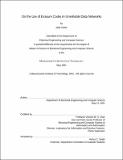| dc.contributor.advisor | Vincent W.S. Chan. | en_US |
| dc.contributor.author | Parikh, Salil (Salil Arvind), 1971- | en_US |
| dc.contributor.other | Massachusetts Institute of Technology. Dept. of Electrical Engineering and Computer Science. | en_US |
| dc.date.accessioned | 2006-06-20T12:51:50Z | |
| dc.date.available | 2006-06-20T12:51:50Z | |
| dc.date.copyright | 2001 | en_US |
| dc.date.issued | 2001 | en_US |
| dc.identifier.uri | http://hdl.handle.net/1721.1/33159 | |
| dc.description | Thesis (S.M.)--Massachusetts Institute of Technology, Dept. of Electrical Engineering and Computer Science, 2001. | en_US |
| dc.description | This electronic version was submitted by the student author. The certified thesis is available in the Institute Archives and Special Collections. | en_US |
| dc.description | Includes bibliographical references (p. 62-64). | en_US |
| dc.description.abstract | Modern data networks are approaching the state where a large number of independent and heterogeneous paths are available between a source node and destination node. In this work, we explore the case where each path has an independent level of reliability characterized by a probability of path failure. Instead of simply repeating the message across all the paths, we use the path diversity to achieve reliable transmission of messages by using a coding technique known as an erasure correcting code. We develop a model of the network and present an analysis of the system that invokes the Central Limit Theorem to approximate the total number of bits received from all the paths. We then optimize the number of bits to send over each path in order to maximize the probability of receiving a sufficient number of bits at the destination to reconstruct the message using the erasure correcting code. Three cases are investigated: when the paths are very reliable, when the paths are very unreliable, and when the paths have a probability of failure within an interval surrounding 0.5. We present an overview of the mechanics of an erasure coding process applicable to packet-based transactions. Finally, as avenues for further research, we discuss several applications of erasure coding in networks that have only a single path between source and destination: for latency reduction in interactive web sessions; as a transport layer for critical messaging; and an application layer protocol for high-bandwidth networks. | en_US |
| dc.description.statementofresponsibility | by Salil Parikh. | en_US |
| dc.format.extent | 64 p. | en_US |
| dc.format.extent | 346500 bytes | |
| dc.format.extent | 346503 bytes | |
| dc.format.mimetype | application/pdf | |
| dc.format.mimetype | application/pdf | |
| dc.language.iso | eng | en_US |
| dc.publisher | Massachusetts Institute of Technology | en_US |
| dc.rights | M.I.T. theses are protected by copyright. They may be viewed from this source for any purpose, but reproduction or distribution in any format is prohibited without written permission. See provided URL for inquiries about permission. | en_US |
| dc.rights.uri | http://dspace.mit.edu/handle/1721.1/7582 | |
| dc.subject | Electrical Engineering and Computer Science. | en_US |
| dc.title | On the use of erasure codes in unreliable data networks | en_US |
| dc.type | Thesis | en_US |
| dc.description.degree | S.M. | en_US |
| dc.contributor.department | Massachusetts Institute of Technology. Department of Electrical Engineering and Computer Science | |
| dc.identifier.oclc | 49234455 | en_US |
